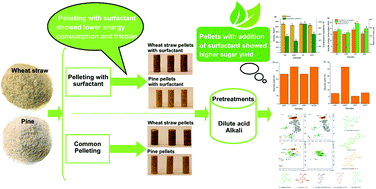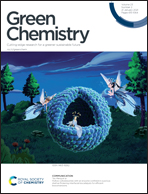Double bonus: surfactant-assisted biomass pelleting benefits both the pelleting process and subsequent enzymatic saccharification of the pretreated pellets†
Abstract
Pelleting overcomes the utilization limitation of lignocellulosic biomass due to its low density and related processing costs. Efficiently combining biomass pelleting and enzymatic saccharification is a challenge for applying biomass with low density in a biorefinery. In this study, we propose a novel biomass processing approach involving the addition of surfactant during pelleting and using the pellets for pretreatment and enzymatic saccharification. We investigated the effects of polyethylene glycol (PEG) 6000 assisted pelleting on pelleting specific energy consumption and friction, and on subsequent pretreatment as well as on enzymatic saccharification of the pretreated pellets. The results showed that PEG 6000 assisted pelleting decreased the total pelleting specific energy consumption by about 14% for wheat straw and 18% for pine, and reduced the maximum friction during ejection of pellets by about 34% for wheat straw and 29% for pine. PEG 6000 assisted pelleting enhanced subsequent enzymatic sugar yield effectively for both acid and alkaline pretreated wheat straw and pine, especially for acid-treated pine pellets, where a 256% increase in glucose yield was obtained. The results suggest that PEG 6000 decreases the cleavage of β-O-4′ linkages during pretreatment and thus hinders the formation of phenolic hydroxyl groups, contributing to the enhanced sugar yield in enzymatic saccharification. As surfactants were found to have beneficial effects on both biomass pelleting and the sugar yield obtained from the enzymatic saccharification of the pretreated pellets, it would be advantageous to add surfactants during pelletizing when the pellets are intended for application in a biorefinery.



 Please wait while we load your content...
Please wait while we load your content...